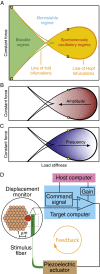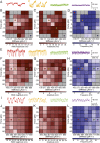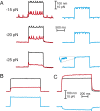Control of a hair bundle's mechanosensory function by its mechanical load
- PMID: 25691749
- PMCID: PMC4352782
- DOI: 10.1073/pnas.1501453112
Control of a hair bundle's mechanosensory function by its mechanical load
Abstract
Hair cells, the sensory receptors of the internal ear, subserve different functions in various receptor organs: they detect oscillatory stimuli in the auditory system, but transduce constant and step stimuli in the vestibular and lateral-line systems. We show that a hair cell's function can be controlled experimentally by adjusting its mechanical load. By making bundles from a single organ operate as any of four distinct types of signal detector, we demonstrate that altering only a few key parameters can fundamentally change a sensory cell's role. The motions of a single hair bundle can resemble those of a bundle from the amphibian vestibular system, the reptilian auditory system, or the mammalian auditory system, demonstrating an essential similarity of bundles across species and receptor organs.
Keywords: Hopf bifurcation; auditory system; dynamical system; hair cell; vestibular system.
Conflict of interest statement
The authors declare no conflict of interest.
Figures





References
-
- Martin P. 2010. Active hair-bundle motility of the hair cells of vestibular and auditory organs. Active Processes and Otoacoustic Emissions, Springer Handbook of Auditory Research, eds Manley GA, Fay RR, Popper AN (Springer Science and Business Media, New York), pp 93–143.
-
- Simmons DD, Meenderink SWF, Vassilakis PN. 2006 Anatomy, physiology, and function of auditory end-organs in the frog inner ear. Hearing and Sound Communication in Amphibians, Springer Handbook of Auditory Research, eds Narins PM, Feng AS, Fay RR, Popper AN (Springer Science and Business Media, New York), pp 184–220.
-
- Hudspeth AJ. Integrating the active process of hair cells with cochlear function. Nat Rev Neurosci. 2014;15(9):600–614. - PubMed
Publication types
MeSH terms
Grants and funding
LinkOut - more resources
Full Text Sources
Other Literature Sources

